Accounting Report: Financial Strategies for Growth and Development
VerifiedAdded on 2022/11/29
|12
|3067
|79
Report
AI Summary
This report provides a comprehensive overview of financial accounting, encompassing essential concepts such as budgeting, forecasting, ratio analysis, operational and forecasted budgets, and pricing decisions. It explores the advantages and disadvantages of these financial strategies, illustrating their impact on organizational success. The report delves into budgeting's role in resource allocation and performance monitoring, forecasting's use in predicting future outcomes, ratio analysis in assessing company performance, the function of operational and forecasted budgets in achieving organizational goals, and the different pricing decisions. Through examples and detailed explanations, the report emphasizes how these financial strategies contribute to informed decision-making and facilitate growth opportunities for organizations.
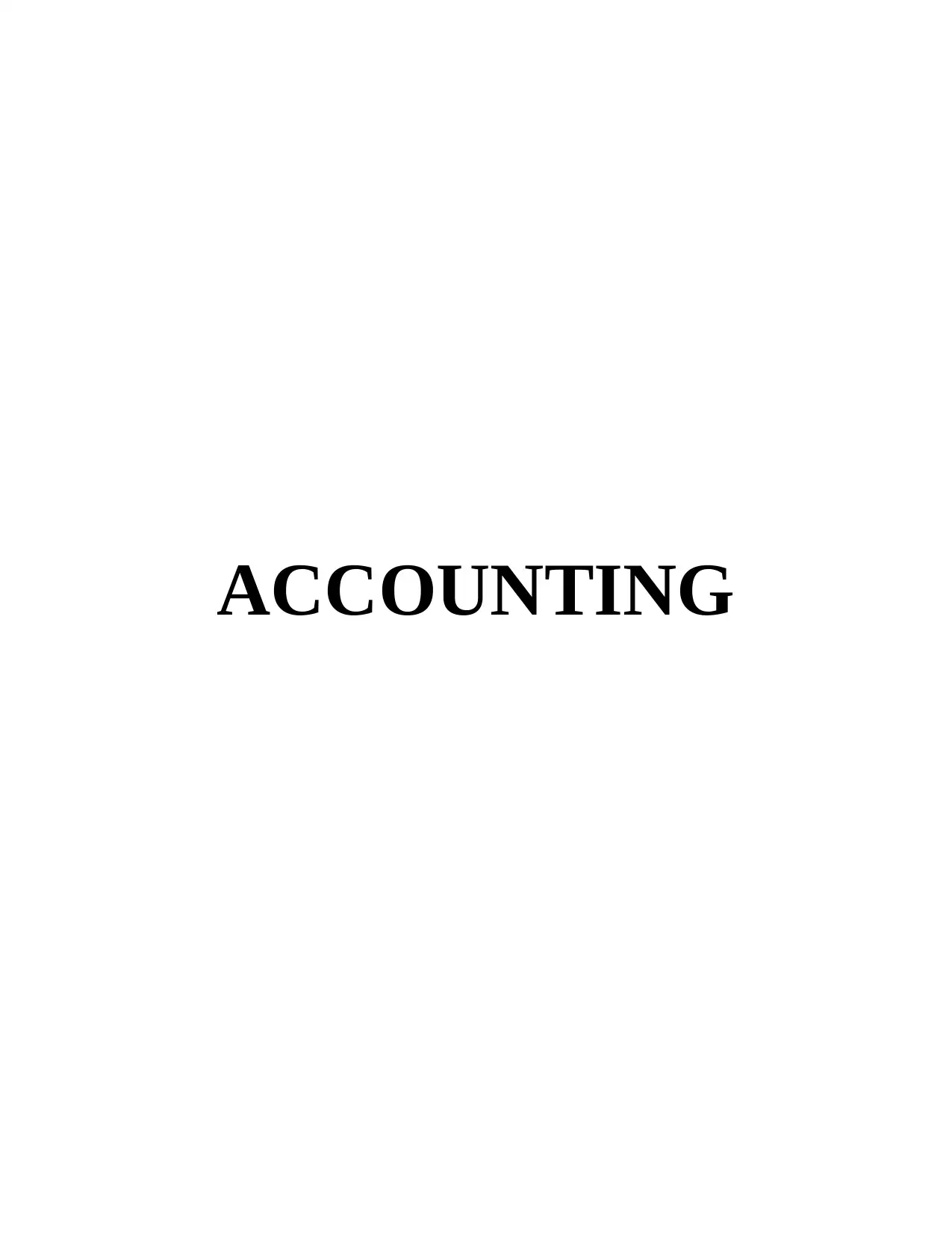
ACCOUNTING
Paraphrase This Document
Need a fresh take? Get an instant paraphrase of this document with our AI Paraphraser
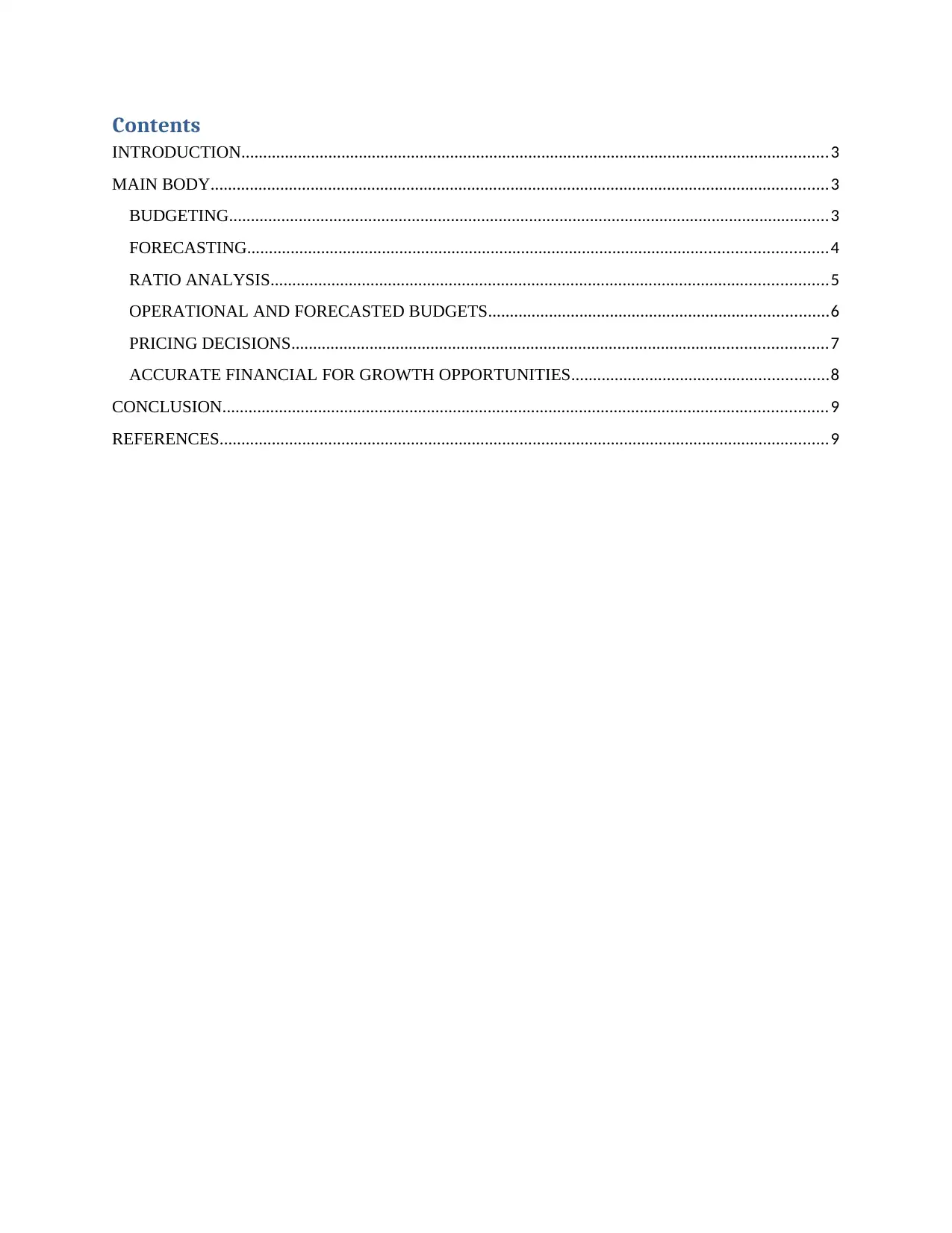
Contents
INTRODUCTION.......................................................................................................................................3
MAIN BODY..............................................................................................................................................3
BUDGETING..........................................................................................................................................3
FORECASTING.....................................................................................................................................4
RATIO ANALYSIS................................................................................................................................5
OPERATIONAL AND FORECASTED BUDGETS..............................................................................6
PRICING DECISIONS...........................................................................................................................7
ACCURATE FINANCIAL FOR GROWTH OPPORTUNITIES...........................................................8
CONCLUSION...........................................................................................................................................9
REFERENCES............................................................................................................................................9
INTRODUCTION.......................................................................................................................................3
MAIN BODY..............................................................................................................................................3
BUDGETING..........................................................................................................................................3
FORECASTING.....................................................................................................................................4
RATIO ANALYSIS................................................................................................................................5
OPERATIONAL AND FORECASTED BUDGETS..............................................................................6
PRICING DECISIONS...........................................................................................................................7
ACCURATE FINANCIAL FOR GROWTH OPPORTUNITIES...........................................................8
CONCLUSION...........................................................................................................................................9
REFERENCES............................................................................................................................................9
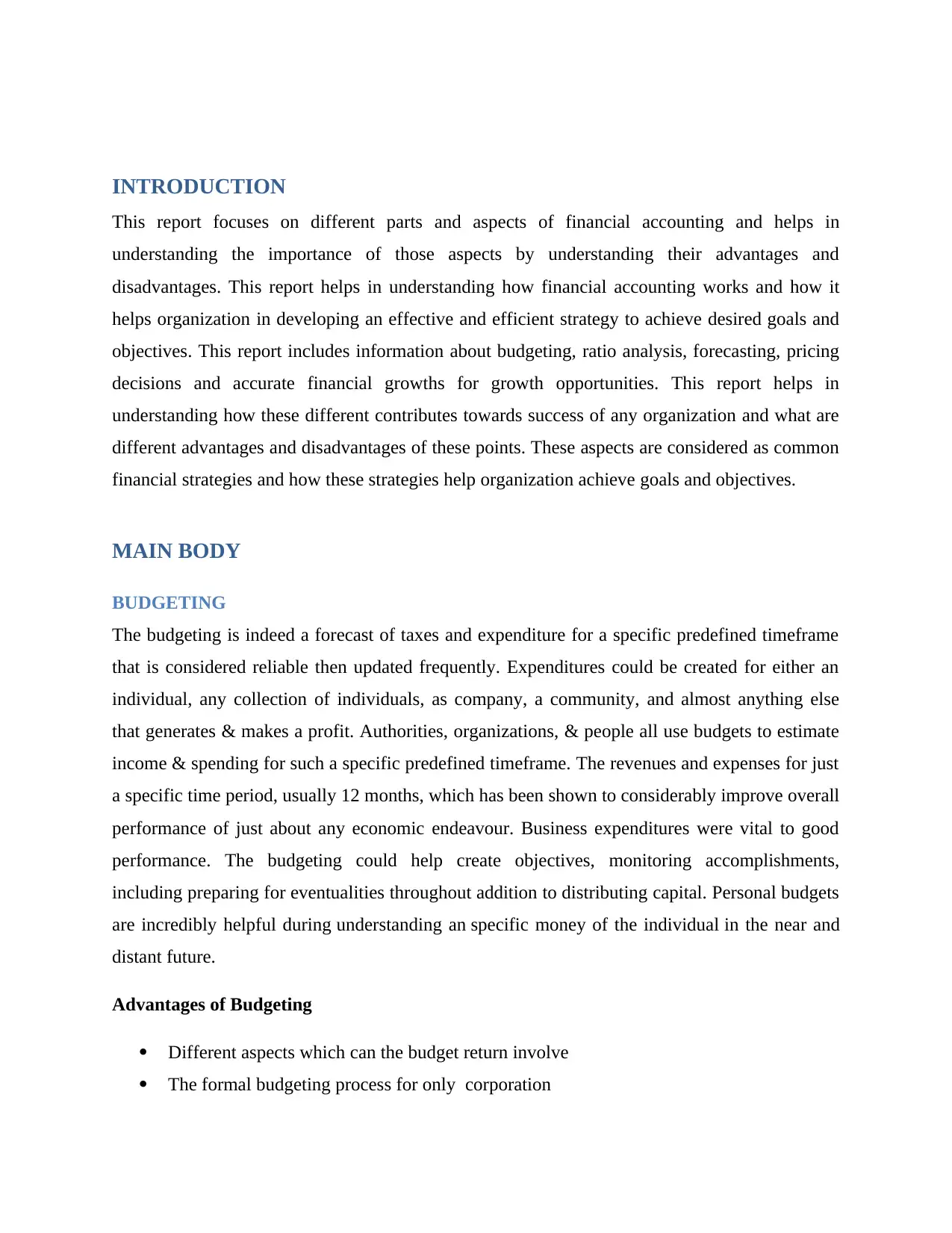
INTRODUCTION
This report focuses on different parts and aspects of financial accounting and helps in
understanding the importance of those aspects by understanding their advantages and
disadvantages. This report helps in understanding how financial accounting works and how it
helps organization in developing an effective and efficient strategy to achieve desired goals and
objectives. This report includes information about budgeting, ratio analysis, forecasting, pricing
decisions and accurate financial growths for growth opportunities. This report helps in
understanding how these different contributes towards success of any organization and what are
different advantages and disadvantages of these points. These aspects are considered as common
financial strategies and how these strategies help organization achieve goals and objectives.
MAIN BODY
BUDGETING
The budgeting is indeed a forecast of taxes and expenditure for a specific predefined timeframe
that is considered reliable then updated frequently. Expenditures could be created for either an
individual, any collection of individuals, as company, a community, and almost anything else
that generates & makes a profit. Authorities, organizations, & people all use budgets to estimate
income & spending for such a specific predefined timeframe. The revenues and expenses for just
a specific time period, usually 12 months, which has been shown to considerably improve overall
performance of just about any economic endeavour. Business expenditures were vital to good
performance. The budgeting could help create objectives, monitoring accomplishments,
including preparing for eventualities throughout addition to distributing capital. Personal budgets
are incredibly helpful during understanding an specific money of the individual in the near and
distant future.
Advantages of Budgeting
Different aspects which can the budget return involve
The formal budgeting process for only corporation
This report focuses on different parts and aspects of financial accounting and helps in
understanding the importance of those aspects by understanding their advantages and
disadvantages. This report helps in understanding how financial accounting works and how it
helps organization in developing an effective and efficient strategy to achieve desired goals and
objectives. This report includes information about budgeting, ratio analysis, forecasting, pricing
decisions and accurate financial growths for growth opportunities. This report helps in
understanding how these different contributes towards success of any organization and what are
different advantages and disadvantages of these points. These aspects are considered as common
financial strategies and how these strategies help organization achieve goals and objectives.
MAIN BODY
BUDGETING
The budgeting is indeed a forecast of taxes and expenditure for a specific predefined timeframe
that is considered reliable then updated frequently. Expenditures could be created for either an
individual, any collection of individuals, as company, a community, and almost anything else
that generates & makes a profit. Authorities, organizations, & people all use budgets to estimate
income & spending for such a specific predefined timeframe. The revenues and expenses for just
a specific time period, usually 12 months, which has been shown to considerably improve overall
performance of just about any economic endeavour. Business expenditures were vital to good
performance. The budgeting could help create objectives, monitoring accomplishments,
including preparing for eventualities throughout addition to distributing capital. Personal budgets
are incredibly helpful during understanding an specific money of the individual in the near and
distant future.
Advantages of Budgeting
Different aspects which can the budget return involve
The formal budgeting process for only corporation
⊘ This is a preview!⊘
Do you want full access?
Subscribe today to unlock all pages.

Trusted by 1+ million students worldwide

Budgeting & strategic design
The advantages of the financial plan
Establishing a financial plan
The processes involved in creating a plan
Help in determining different aspects the budgeting should include
How organization have to include within the budgeting
Make the using the budget for monitor organization progress.
Periodically check the spending.
Disadvantages of Budgeting
Sometimes it can be inaccurate.
It needs effective decision making.
Rigid decision making is involved during the process.
Budgeting can sometimes involves risks of being vulnerable to losses.
Outcomes can be different from what to be expected before planning of budget
Resources can sometimes be less in abundance which can affect organization planning.
Effective financial outcomes are dependent on the budgeting of organization..
Example - Company A's sales staff has set a goal of selling 10,000 mobile phones at $100 each.
On the other side, the production team has set a goal of producing 9000 units using the current
resources. In this instance, management must determine whether or not to pursue the sales goal
and allocate additional resources to the manufacturing team. Alternatively, follow the production
team's target and risk losing out on more money.
FORECASTING
This part of report helps in understanding financial forecasting which examines previous data
that predict a corporation's expected investment results. This part involves financial forecasting
which enables executives to predict outcomes looking at historical accounting transactions.
Forecasting has the following advantages. For example, a business could have quarterly profit
predictions. Forecasting is indeed a program that utilizes previous information as input and
generates well-informed predictions more about towards direction of sustainable developments
The advantages of the financial plan
Establishing a financial plan
The processes involved in creating a plan
Help in determining different aspects the budgeting should include
How organization have to include within the budgeting
Make the using the budget for monitor organization progress.
Periodically check the spending.
Disadvantages of Budgeting
Sometimes it can be inaccurate.
It needs effective decision making.
Rigid decision making is involved during the process.
Budgeting can sometimes involves risks of being vulnerable to losses.
Outcomes can be different from what to be expected before planning of budget
Resources can sometimes be less in abundance which can affect organization planning.
Effective financial outcomes are dependent on the budgeting of organization..
Example - Company A's sales staff has set a goal of selling 10,000 mobile phones at $100 each.
On the other side, the production team has set a goal of producing 9000 units using the current
resources. In this instance, management must determine whether or not to pursue the sales goal
and allocate additional resources to the manufacturing team. Alternatively, follow the production
team's target and risk losing out on more money.
FORECASTING
This part of report helps in understanding financial forecasting which examines previous data
that predict a corporation's expected investment results. This part involves financial forecasting
which enables executives to predict outcomes looking at historical accounting transactions.
Forecasting has the following advantages. For example, a business could have quarterly profit
predictions. Forecasting is indeed a program that utilizes previous information as input and
generates well-informed predictions more about towards direction of sustainable developments
Paraphrase This Document
Need a fresh take? Get an instant paraphrase of this document with our AI Paraphraser
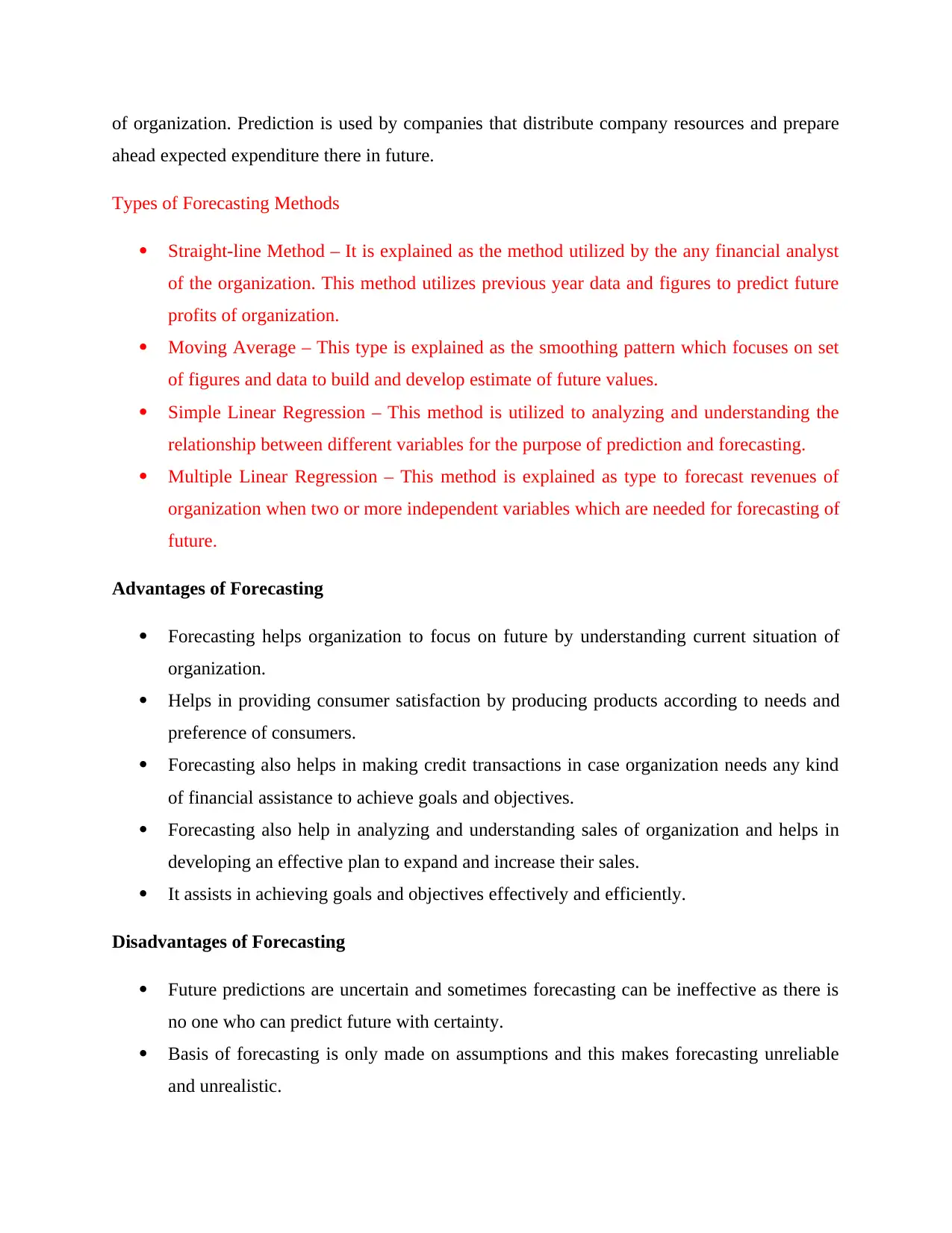
of organization. Prediction is used by companies that distribute company resources and prepare
ahead expected expenditure there in future.
Types of Forecasting Methods
Straight-line Method – It is explained as the method utilized by the any financial analyst
of the organization. This method utilizes previous year data and figures to predict future
profits of organization.
Moving Average – This type is explained as the smoothing pattern which focuses on set
of figures and data to build and develop estimate of future values.
Simple Linear Regression – This method is utilized to analyzing and understanding the
relationship between different variables for the purpose of prediction and forecasting.
Multiple Linear Regression – This method is explained as type to forecast revenues of
organization when two or more independent variables which are needed for forecasting of
future.
Advantages of Forecasting
Forecasting helps organization to focus on future by understanding current situation of
organization.
Helps in providing consumer satisfaction by producing products according to needs and
preference of consumers.
Forecasting also helps in making credit transactions in case organization needs any kind
of financial assistance to achieve goals and objectives.
Forecasting also help in analyzing and understanding sales of organization and helps in
developing an effective plan to expand and increase their sales.
It assists in achieving goals and objectives effectively and efficiently.
Disadvantages of Forecasting
Future predictions are uncertain and sometimes forecasting can be ineffective as there is
no one who can predict future with certainty.
Basis of forecasting is only made on assumptions and this makes forecasting unreliable
and unrealistic.
ahead expected expenditure there in future.
Types of Forecasting Methods
Straight-line Method – It is explained as the method utilized by the any financial analyst
of the organization. This method utilizes previous year data and figures to predict future
profits of organization.
Moving Average – This type is explained as the smoothing pattern which focuses on set
of figures and data to build and develop estimate of future values.
Simple Linear Regression – This method is utilized to analyzing and understanding the
relationship between different variables for the purpose of prediction and forecasting.
Multiple Linear Regression – This method is explained as type to forecast revenues of
organization when two or more independent variables which are needed for forecasting of
future.
Advantages of Forecasting
Forecasting helps organization to focus on future by understanding current situation of
organization.
Helps in providing consumer satisfaction by producing products according to needs and
preference of consumers.
Forecasting also helps in making credit transactions in case organization needs any kind
of financial assistance to achieve goals and objectives.
Forecasting also help in analyzing and understanding sales of organization and helps in
developing an effective plan to expand and increase their sales.
It assists in achieving goals and objectives effectively and efficiently.
Disadvantages of Forecasting
Future predictions are uncertain and sometimes forecasting can be ineffective as there is
no one who can predict future with certainty.
Basis of forecasting is only made on assumptions and this makes forecasting unreliable
and unrealistic.
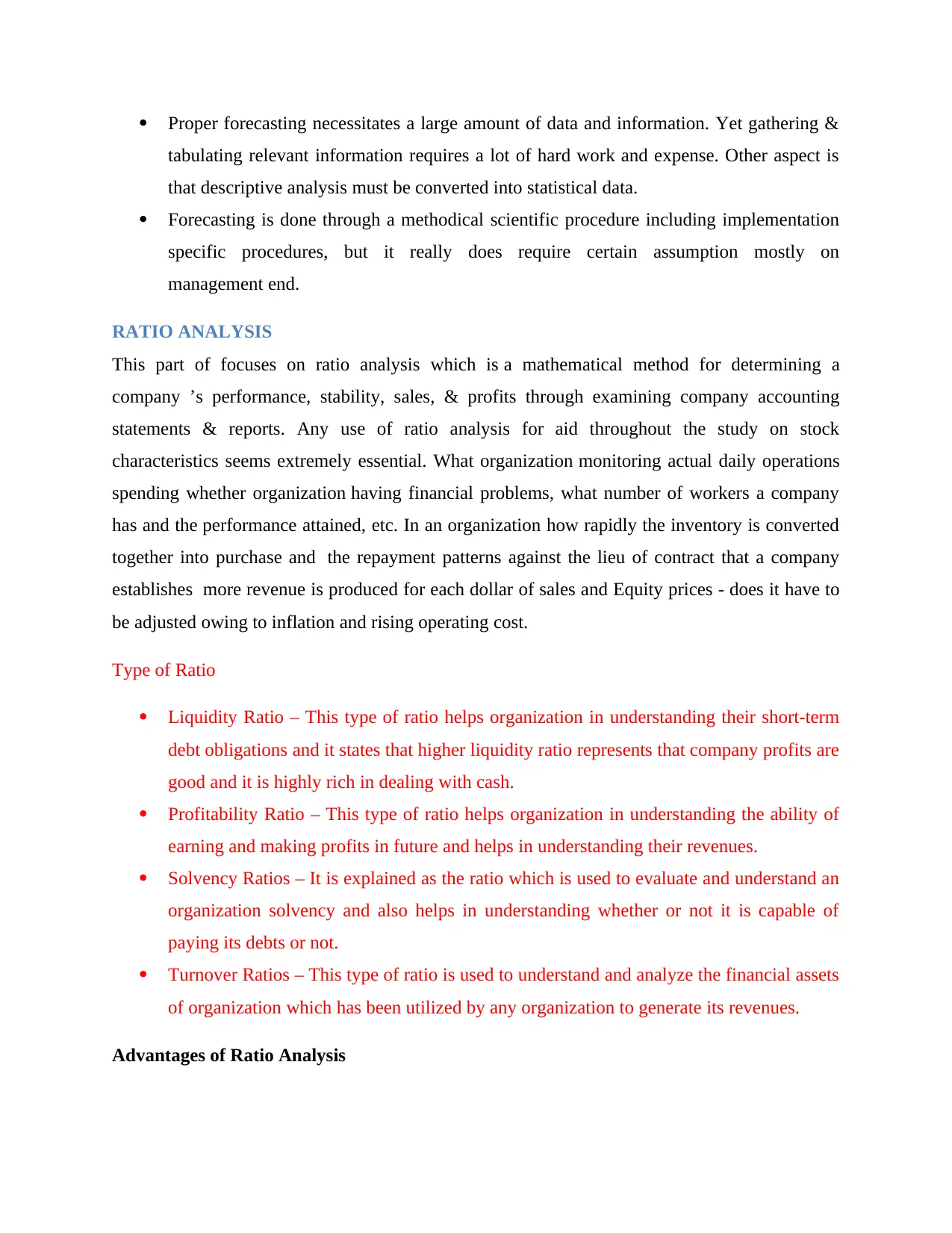
Proper forecasting necessitates a large amount of data and information. Yet gathering &
tabulating relevant information requires a lot of hard work and expense. Other aspect is
that descriptive analysis must be converted into statistical data.
Forecasting is done through a methodical scientific procedure including implementation
specific procedures, but it really does require certain assumption mostly on
management end.
RATIO ANALYSIS
This part of focuses on ratio analysis which is a mathematical method for determining a
company ’s performance, stability, sales, & profits through examining company accounting
statements & reports. Any use of ratio analysis for aid throughout the study on stock
characteristics seems extremely essential. What organization monitoring actual daily operations
spending whether organization having financial problems, what number of workers a company
has and the performance attained, etc. In an organization how rapidly the inventory is converted
together into purchase and the repayment patterns against the lieu of contract that a company
establishes more revenue is produced for each dollar of sales and Equity prices - does it have to
be adjusted owing to inflation and rising operating cost.
Type of Ratio
Liquidity Ratio – This type of ratio helps organization in understanding their short-term
debt obligations and it states that higher liquidity ratio represents that company profits are
good and it is highly rich in dealing with cash.
Profitability Ratio – This type of ratio helps organization in understanding the ability of
earning and making profits in future and helps in understanding their revenues.
Solvency Ratios – It is explained as the ratio which is used to evaluate and understand an
organization solvency and also helps in understanding whether or not it is capable of
paying its debts or not.
Turnover Ratios – This type of ratio is used to understand and analyze the financial assets
of organization which has been utilized by any organization to generate its revenues.
Advantages of Ratio Analysis
tabulating relevant information requires a lot of hard work and expense. Other aspect is
that descriptive analysis must be converted into statistical data.
Forecasting is done through a methodical scientific procedure including implementation
specific procedures, but it really does require certain assumption mostly on
management end.
RATIO ANALYSIS
This part of focuses on ratio analysis which is a mathematical method for determining a
company ’s performance, stability, sales, & profits through examining company accounting
statements & reports. Any use of ratio analysis for aid throughout the study on stock
characteristics seems extremely essential. What organization monitoring actual daily operations
spending whether organization having financial problems, what number of workers a company
has and the performance attained, etc. In an organization how rapidly the inventory is converted
together into purchase and the repayment patterns against the lieu of contract that a company
establishes more revenue is produced for each dollar of sales and Equity prices - does it have to
be adjusted owing to inflation and rising operating cost.
Type of Ratio
Liquidity Ratio – This type of ratio helps organization in understanding their short-term
debt obligations and it states that higher liquidity ratio represents that company profits are
good and it is highly rich in dealing with cash.
Profitability Ratio – This type of ratio helps organization in understanding the ability of
earning and making profits in future and helps in understanding their revenues.
Solvency Ratios – It is explained as the ratio which is used to evaluate and understand an
organization solvency and also helps in understanding whether or not it is capable of
paying its debts or not.
Turnover Ratios – This type of ratio is used to understand and analyze the financial assets
of organization which has been utilized by any organization to generate its revenues.
Advantages of Ratio Analysis
⊘ This is a preview!⊘
Do you want full access?
Subscribe today to unlock all pages.

Trusted by 1+ million students worldwide
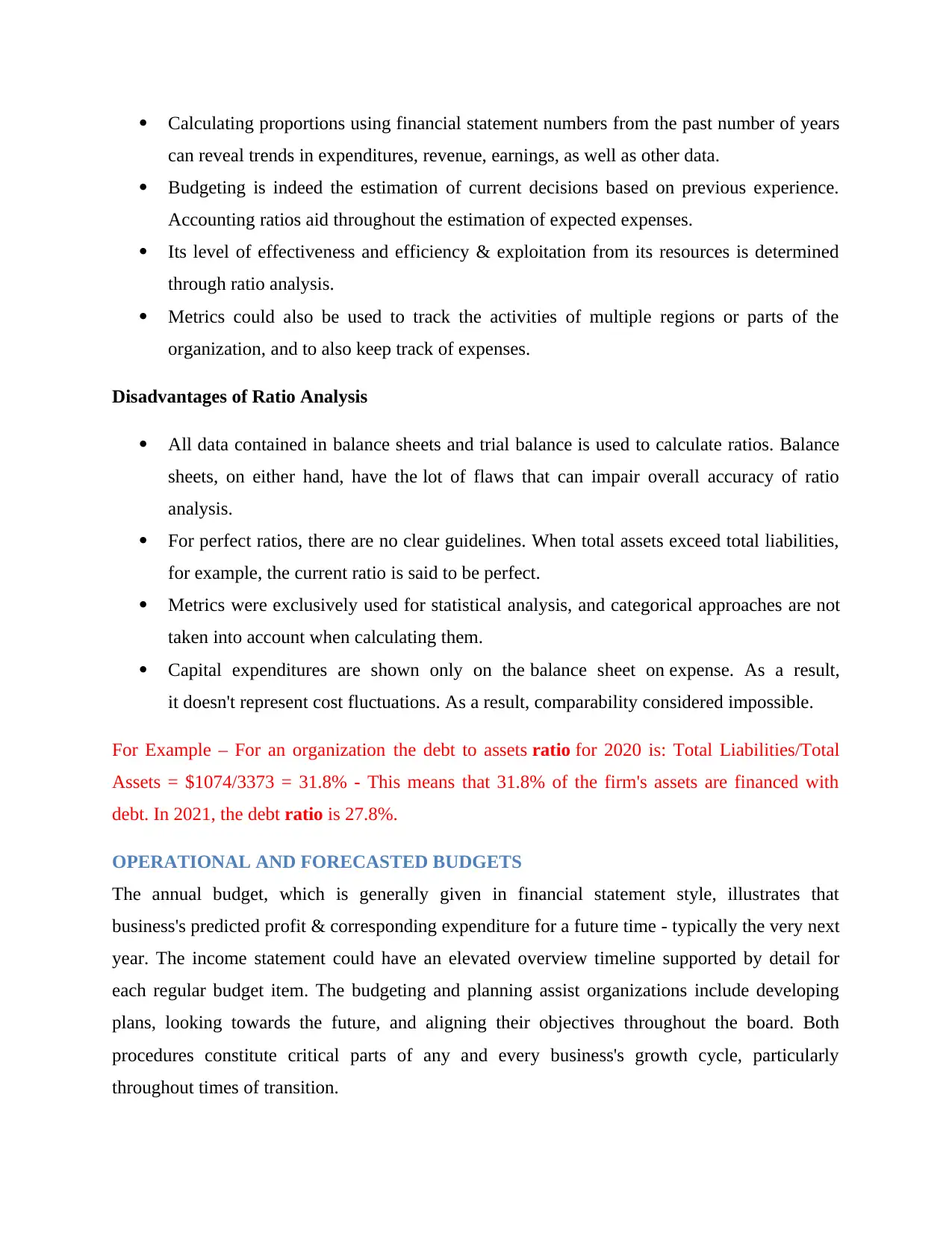
Calculating proportions using financial statement numbers from the past number of years
can reveal trends in expenditures, revenue, earnings, as well as other data.
Budgeting is indeed the estimation of current decisions based on previous experience.
Accounting ratios aid throughout the estimation of expected expenses.
Its level of effectiveness and efficiency & exploitation from its resources is determined
through ratio analysis.
Metrics could also be used to track the activities of multiple regions or parts of the
organization, and to also keep track of expenses.
Disadvantages of Ratio Analysis
All data contained in balance sheets and trial balance is used to calculate ratios. Balance
sheets, on either hand, have the lot of flaws that can impair overall accuracy of ratio
analysis.
For perfect ratios, there are no clear guidelines. When total assets exceed total liabilities,
for example, the current ratio is said to be perfect.
Metrics were exclusively used for statistical analysis, and categorical approaches are not
taken into account when calculating them.
Capital expenditures are shown only on the balance sheet on expense. As a result,
it doesn't represent cost fluctuations. As a result, comparability considered impossible.
For Example – For an organization the debt to assets ratio for 2020 is: Total Liabilities/Total
Assets = $1074/3373 = 31.8% - This means that 31.8% of the firm's assets are financed with
debt. In 2021, the debt ratio is 27.8%.
OPERATIONAL AND FORECASTED BUDGETS
The annual budget, which is generally given in financial statement style, illustrates that
business's predicted profit & corresponding expenditure for a future time - typically the very next
year. The income statement could have an elevated overview timeline supported by detail for
each regular budget item. The budgeting and planning assist organizations include developing
plans, looking towards the future, and aligning their objectives throughout the board. Both
procedures constitute critical parts of any and every business's growth cycle, particularly
throughout times of transition.
can reveal trends in expenditures, revenue, earnings, as well as other data.
Budgeting is indeed the estimation of current decisions based on previous experience.
Accounting ratios aid throughout the estimation of expected expenses.
Its level of effectiveness and efficiency & exploitation from its resources is determined
through ratio analysis.
Metrics could also be used to track the activities of multiple regions or parts of the
organization, and to also keep track of expenses.
Disadvantages of Ratio Analysis
All data contained in balance sheets and trial balance is used to calculate ratios. Balance
sheets, on either hand, have the lot of flaws that can impair overall accuracy of ratio
analysis.
For perfect ratios, there are no clear guidelines. When total assets exceed total liabilities,
for example, the current ratio is said to be perfect.
Metrics were exclusively used for statistical analysis, and categorical approaches are not
taken into account when calculating them.
Capital expenditures are shown only on the balance sheet on expense. As a result,
it doesn't represent cost fluctuations. As a result, comparability considered impossible.
For Example – For an organization the debt to assets ratio for 2020 is: Total Liabilities/Total
Assets = $1074/3373 = 31.8% - This means that 31.8% of the firm's assets are financed with
debt. In 2021, the debt ratio is 27.8%.
OPERATIONAL AND FORECASTED BUDGETS
The annual budget, which is generally given in financial statement style, illustrates that
business's predicted profit & corresponding expenditure for a future time - typically the very next
year. The income statement could have an elevated overview timeline supported by detail for
each regular budget item. The budgeting and planning assist organizations include developing
plans, looking towards the future, and aligning their objectives throughout the board. Both
procedures constitute critical parts of any and every business's growth cycle, particularly
throughout times of transition.
Paraphrase This Document
Need a fresh take? Get an instant paraphrase of this document with our AI Paraphraser
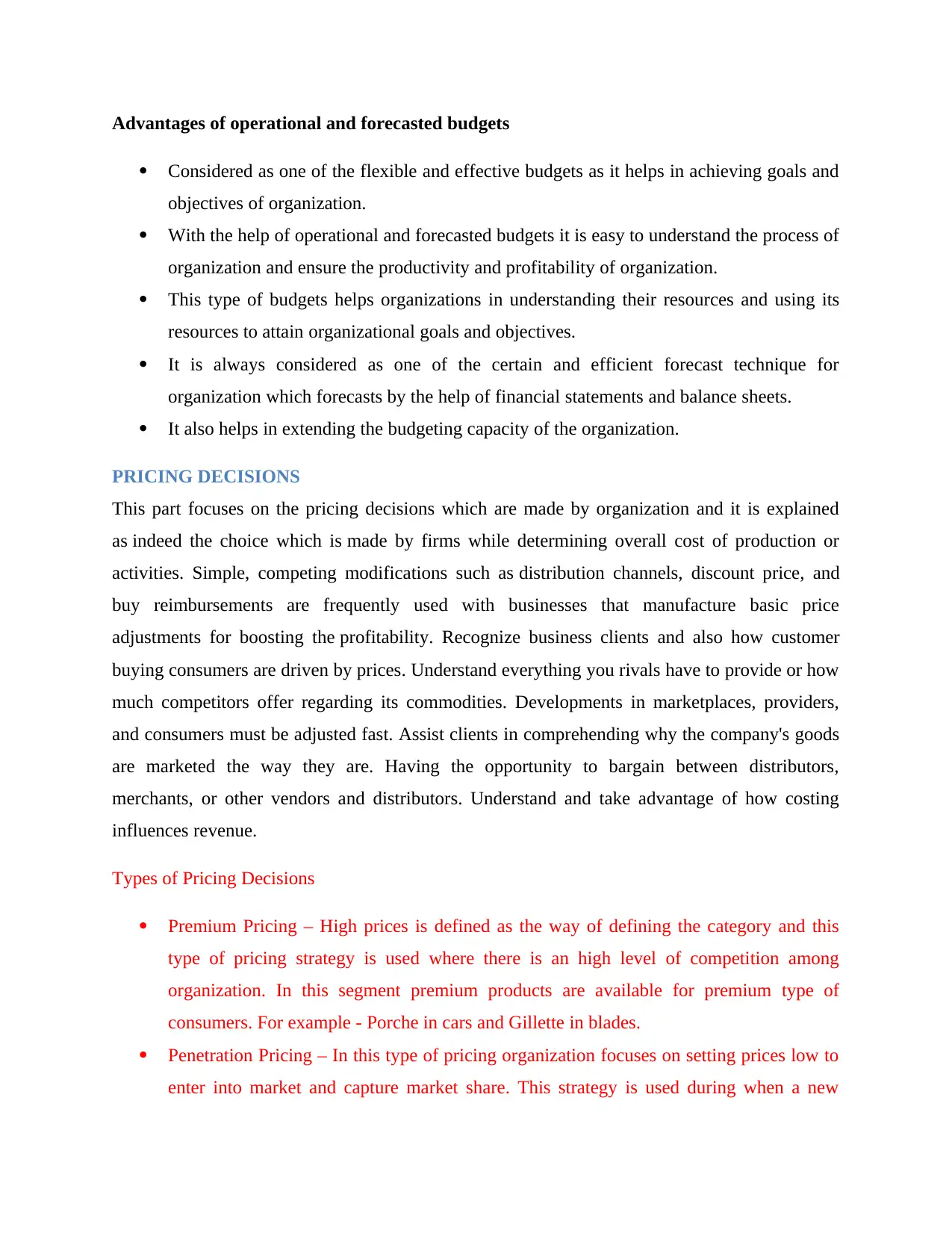
Advantages of operational and forecasted budgets
Considered as one of the flexible and effective budgets as it helps in achieving goals and
objectives of organization.
With the help of operational and forecasted budgets it is easy to understand the process of
organization and ensure the productivity and profitability of organization.
This type of budgets helps organizations in understanding their resources and using its
resources to attain organizational goals and objectives.
It is always considered as one of the certain and efficient forecast technique for
organization which forecasts by the help of financial statements and balance sheets.
It also helps in extending the budgeting capacity of the organization.
PRICING DECISIONS
This part focuses on the pricing decisions which are made by organization and it is explained
as indeed the choice which is made by firms while determining overall cost of production or
activities. Simple, competing modifications such as distribution channels, discount price, and
buy reimbursements are frequently used with businesses that manufacture basic price
adjustments for boosting the profitability. Recognize business clients and also how customer
buying consumers are driven by prices. Understand everything you rivals have to provide or how
much competitors offer regarding its commodities. Developments in marketplaces, providers,
and consumers must be adjusted fast. Assist clients in comprehending why the company's goods
are marketed the way they are. Having the opportunity to bargain between distributors,
merchants, or other vendors and distributors. Understand and take advantage of how costing
influences revenue.
Types of Pricing Decisions
Premium Pricing – High prices is defined as the way of defining the category and this
type of pricing strategy is used where there is an high level of competition among
organization. In this segment premium products are available for premium type of
consumers. For example - Porche in cars and Gillette in blades.
Penetration Pricing – In this type of pricing organization focuses on setting prices low to
enter into market and capture market share. This strategy is used during when a new
Considered as one of the flexible and effective budgets as it helps in achieving goals and
objectives of organization.
With the help of operational and forecasted budgets it is easy to understand the process of
organization and ensure the productivity and profitability of organization.
This type of budgets helps organizations in understanding their resources and using its
resources to attain organizational goals and objectives.
It is always considered as one of the certain and efficient forecast technique for
organization which forecasts by the help of financial statements and balance sheets.
It also helps in extending the budgeting capacity of the organization.
PRICING DECISIONS
This part focuses on the pricing decisions which are made by organization and it is explained
as indeed the choice which is made by firms while determining overall cost of production or
activities. Simple, competing modifications such as distribution channels, discount price, and
buy reimbursements are frequently used with businesses that manufacture basic price
adjustments for boosting the profitability. Recognize business clients and also how customer
buying consumers are driven by prices. Understand everything you rivals have to provide or how
much competitors offer regarding its commodities. Developments in marketplaces, providers,
and consumers must be adjusted fast. Assist clients in comprehending why the company's goods
are marketed the way they are. Having the opportunity to bargain between distributors,
merchants, or other vendors and distributors. Understand and take advantage of how costing
influences revenue.
Types of Pricing Decisions
Premium Pricing – High prices is defined as the way of defining the category and this
type of pricing strategy is used where there is an high level of competition among
organization. In this segment premium products are available for premium type of
consumers. For example - Porche in cars and Gillette in blades.
Penetration Pricing – In this type of pricing organization focuses on setting prices low to
enter into market and capture market share. This strategy is used during when a new
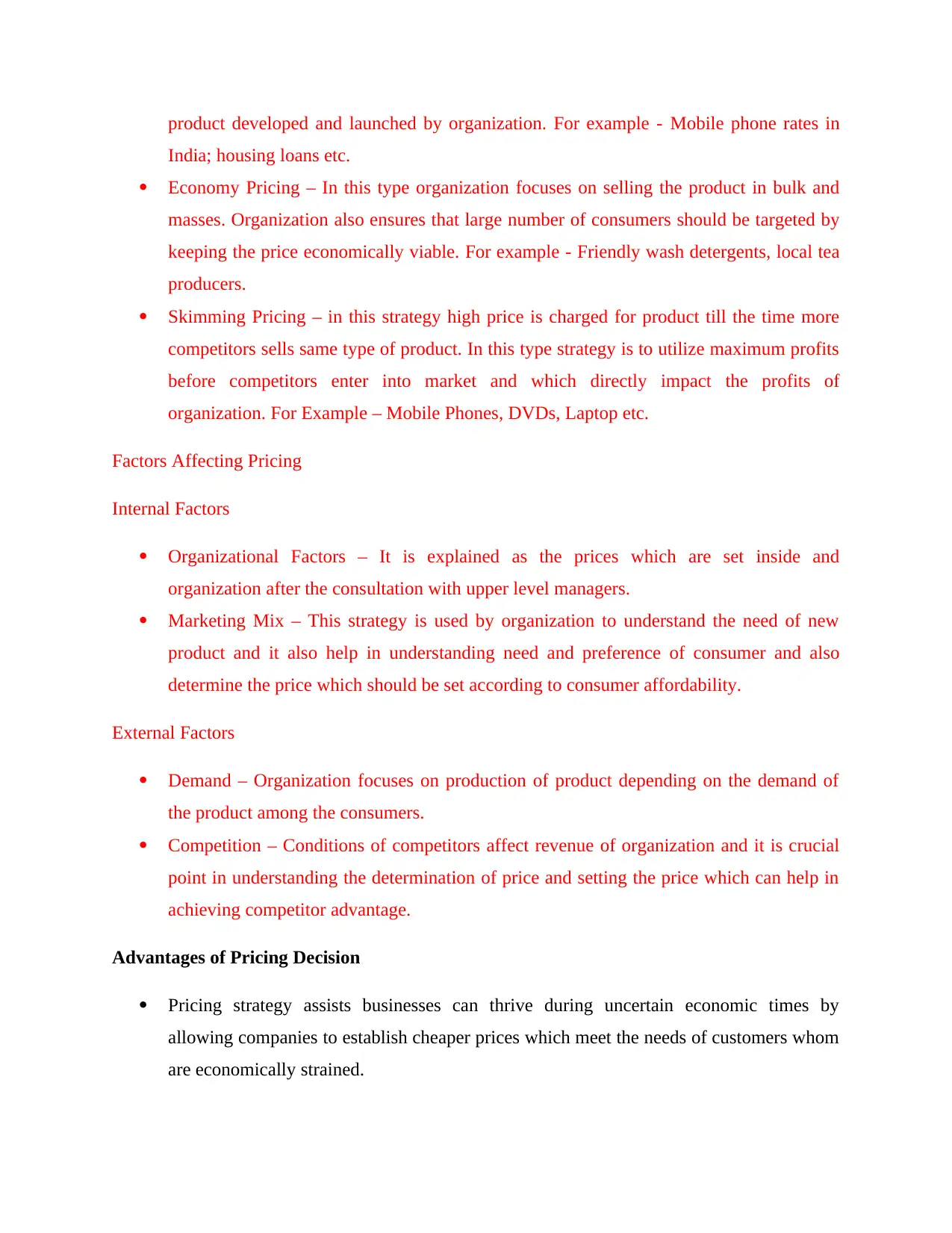
product developed and launched by organization. For example - Mobile phone rates in
India; housing loans etc.
Economy Pricing – In this type organization focuses on selling the product in bulk and
masses. Organization also ensures that large number of consumers should be targeted by
keeping the price economically viable. For example - Friendly wash detergents, local tea
producers.
Skimming Pricing – in this strategy high price is charged for product till the time more
competitors sells same type of product. In this type strategy is to utilize maximum profits
before competitors enter into market and which directly impact the profits of
organization. For Example – Mobile Phones, DVDs, Laptop etc.
Factors Affecting Pricing
Internal Factors
Organizational Factors – It is explained as the prices which are set inside and
organization after the consultation with upper level managers.
Marketing Mix – This strategy is used by organization to understand the need of new
product and it also help in understanding need and preference of consumer and also
determine the price which should be set according to consumer affordability.
External Factors
Demand – Organization focuses on production of product depending on the demand of
the product among the consumers.
Competition – Conditions of competitors affect revenue of organization and it is crucial
point in understanding the determination of price and setting the price which can help in
achieving competitor advantage.
Advantages of Pricing Decision
Pricing strategy assists businesses can thrive during uncertain economic times by
allowing companies to establish cheaper prices which meet the needs of customers whom
are economically strained.
India; housing loans etc.
Economy Pricing – In this type organization focuses on selling the product in bulk and
masses. Organization also ensures that large number of consumers should be targeted by
keeping the price economically viable. For example - Friendly wash detergents, local tea
producers.
Skimming Pricing – in this strategy high price is charged for product till the time more
competitors sells same type of product. In this type strategy is to utilize maximum profits
before competitors enter into market and which directly impact the profits of
organization. For Example – Mobile Phones, DVDs, Laptop etc.
Factors Affecting Pricing
Internal Factors
Organizational Factors – It is explained as the prices which are set inside and
organization after the consultation with upper level managers.
Marketing Mix – This strategy is used by organization to understand the need of new
product and it also help in understanding need and preference of consumer and also
determine the price which should be set according to consumer affordability.
External Factors
Demand – Organization focuses on production of product depending on the demand of
the product among the consumers.
Competition – Conditions of competitors affect revenue of organization and it is crucial
point in understanding the determination of price and setting the price which can help in
achieving competitor advantage.
Advantages of Pricing Decision
Pricing strategy assists businesses can thrive during uncertain economic times by
allowing companies to establish cheaper prices which meet the needs of customers whom
are economically strained.
⊘ This is a preview!⊘
Do you want full access?
Subscribe today to unlock all pages.

Trusted by 1+ million students worldwide
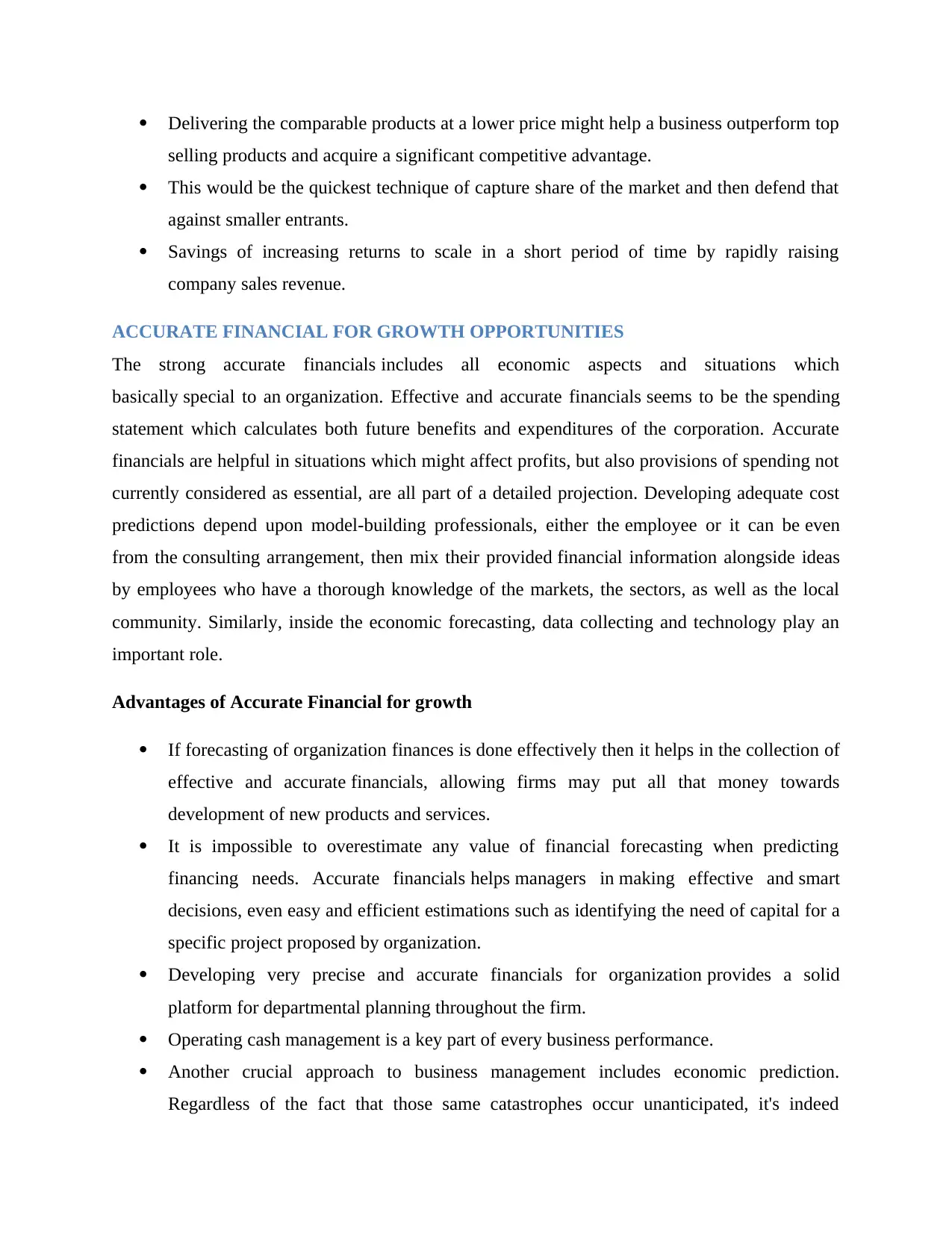
Delivering the comparable products at a lower price might help a business outperform top
selling products and acquire a significant competitive advantage.
This would be the quickest technique of capture share of the market and then defend that
against smaller entrants.
Savings of increasing returns to scale in a short period of time by rapidly raising
company sales revenue.
ACCURATE FINANCIAL FOR GROWTH OPPORTUNITIES
The strong accurate financials includes all economic aspects and situations which
basically special to an organization. Effective and accurate financials seems to be the spending
statement which calculates both future benefits and expenditures of the corporation. Accurate
financials are helpful in situations which might affect profits, but also provisions of spending not
currently considered as essential, are all part of a detailed projection. Developing adequate cost
predictions depend upon model-building professionals, either the employee or it can be even
from the consulting arrangement, then mix their provided financial information alongside ideas
by employees who have a thorough knowledge of the markets, the sectors, as well as the local
community. Similarly, inside the economic forecasting, data collecting and technology play an
important role.
Advantages of Accurate Financial for growth
If forecasting of organization finances is done effectively then it helps in the collection of
effective and accurate financials, allowing firms may put all that money towards
development of new products and services.
It is impossible to overestimate any value of financial forecasting when predicting
financing needs. Accurate financials helps managers in making effective and smart
decisions, even easy and efficient estimations such as identifying the need of capital for a
specific project proposed by organization.
Developing very precise and accurate financials for organization provides a solid
platform for departmental planning throughout the firm.
Operating cash management is a key part of every business performance.
Another crucial approach to business management includes economic prediction.
Regardless of the fact that those same catastrophes occur unanticipated, it's indeed
selling products and acquire a significant competitive advantage.
This would be the quickest technique of capture share of the market and then defend that
against smaller entrants.
Savings of increasing returns to scale in a short period of time by rapidly raising
company sales revenue.
ACCURATE FINANCIAL FOR GROWTH OPPORTUNITIES
The strong accurate financials includes all economic aspects and situations which
basically special to an organization. Effective and accurate financials seems to be the spending
statement which calculates both future benefits and expenditures of the corporation. Accurate
financials are helpful in situations which might affect profits, but also provisions of spending not
currently considered as essential, are all part of a detailed projection. Developing adequate cost
predictions depend upon model-building professionals, either the employee or it can be even
from the consulting arrangement, then mix their provided financial information alongside ideas
by employees who have a thorough knowledge of the markets, the sectors, as well as the local
community. Similarly, inside the economic forecasting, data collecting and technology play an
important role.
Advantages of Accurate Financial for growth
If forecasting of organization finances is done effectively then it helps in the collection of
effective and accurate financials, allowing firms may put all that money towards
development of new products and services.
It is impossible to overestimate any value of financial forecasting when predicting
financing needs. Accurate financials helps managers in making effective and smart
decisions, even easy and efficient estimations such as identifying the need of capital for a
specific project proposed by organization.
Developing very precise and accurate financials for organization provides a solid
platform for departmental planning throughout the firm.
Operating cash management is a key part of every business performance.
Another crucial approach to business management includes economic prediction.
Regardless of the fact that those same catastrophes occur unanticipated, it's indeed
Paraphrase This Document
Need a fresh take? Get an instant paraphrase of this document with our AI Paraphraser
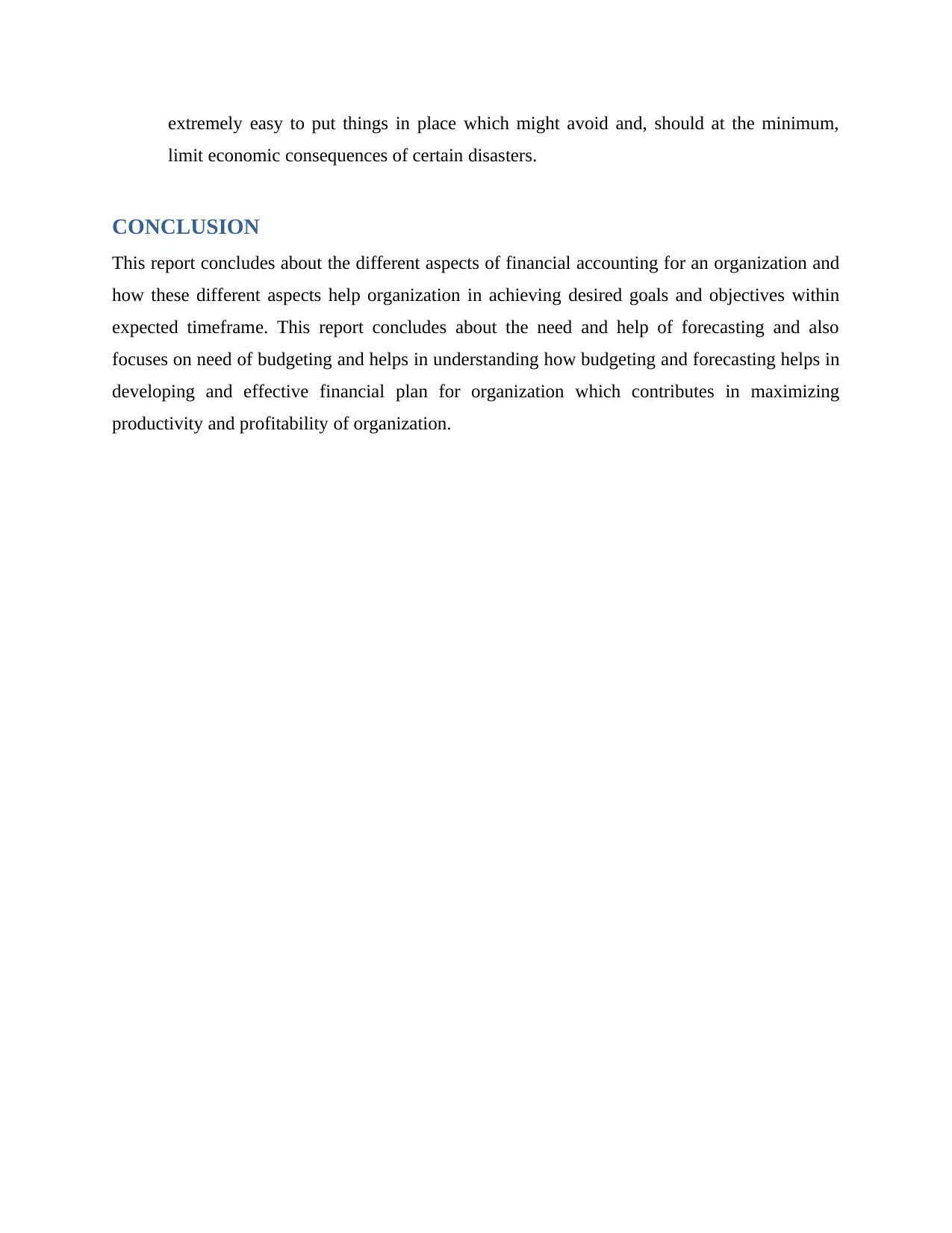
extremely easy to put things in place which might avoid and, should at the minimum,
limit economic consequences of certain disasters.
CONCLUSION
This report concludes about the different aspects of financial accounting for an organization and
how these different aspects help organization in achieving desired goals and objectives within
expected timeframe. This report concludes about the need and help of forecasting and also
focuses on need of budgeting and helps in understanding how budgeting and forecasting helps in
developing and effective financial plan for organization which contributes in maximizing
productivity and profitability of organization.
limit economic consequences of certain disasters.
CONCLUSION
This report concludes about the different aspects of financial accounting for an organization and
how these different aspects help organization in achieving desired goals and objectives within
expected timeframe. This report concludes about the need and help of forecasting and also
focuses on need of budgeting and helps in understanding how budgeting and forecasting helps in
developing and effective financial plan for organization which contributes in maximizing
productivity and profitability of organization.
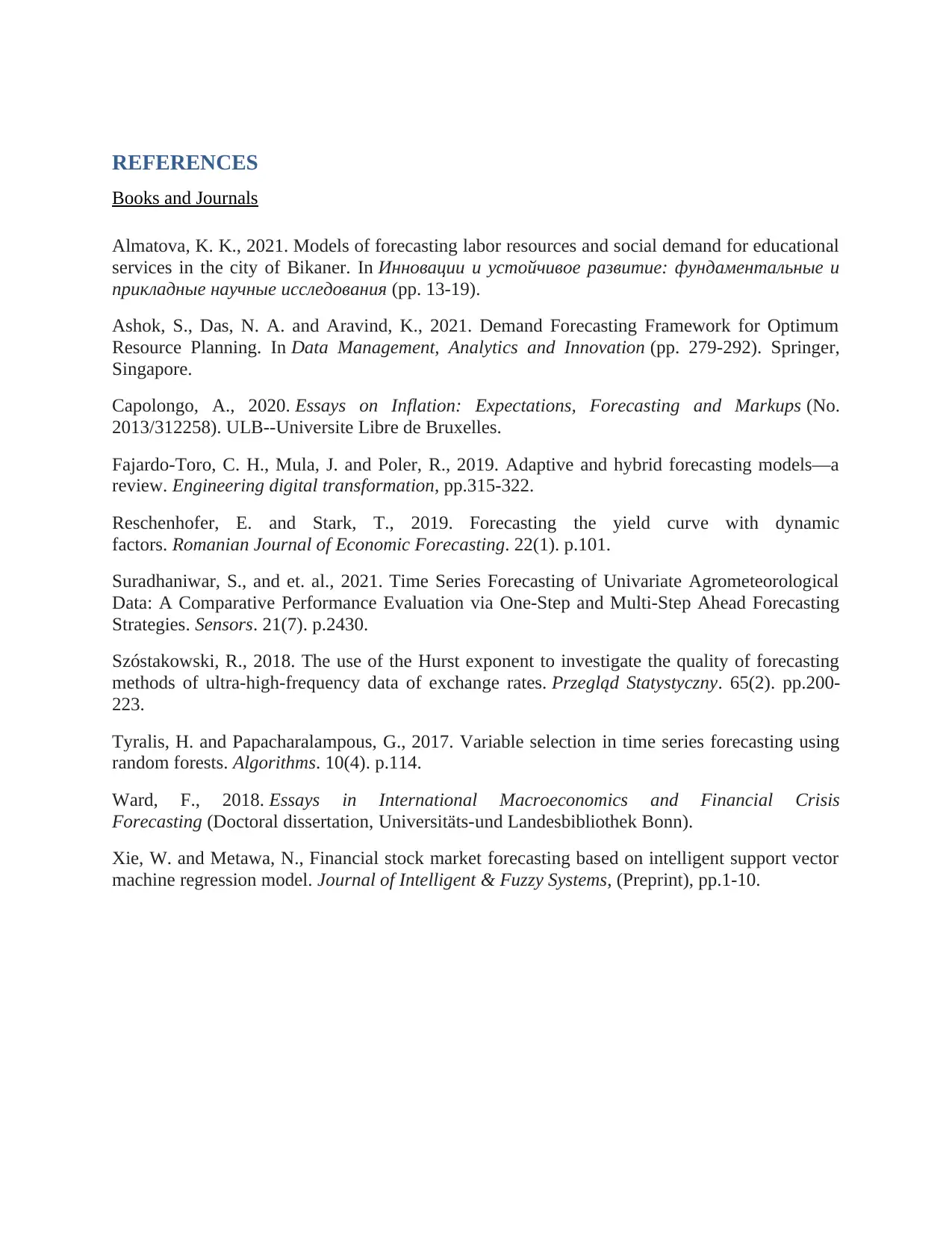
REFERENCES
Books and Journals
Almatova, K. K., 2021. Models of forecasting labor resources and social demand for educational
services in the city of Bikaner. In Инновации и устойчивое развитие: фундаментальные и
прикладные научные исследования (pp. 13-19).
Ashok, S., Das, N. A. and Aravind, K., 2021. Demand Forecasting Framework for Optimum
Resource Planning. In Data Management, Analytics and Innovation (pp. 279-292). Springer,
Singapore.
Capolongo, A., 2020. Essays on Inflation: Expectations, Forecasting and Markups (No.
2013/312258). ULB--Universite Libre de Bruxelles.
Fajardo-Toro, C. H., Mula, J. and Poler, R., 2019. Adaptive and hybrid forecasting models—a
review. Engineering digital transformation, pp.315-322.
Reschenhofer, E. and Stark, T., 2019. Forecasting the yield curve with dynamic
factors. Romanian Journal of Economic Forecasting. 22(1). p.101.
Suradhaniwar, S., and et. al., 2021. Time Series Forecasting of Univariate Agrometeorological
Data: A Comparative Performance Evaluation via One-Step and Multi-Step Ahead Forecasting
Strategies. Sensors. 21(7). p.2430.
Szóstakowski, R., 2018. The use of the Hurst exponent to investigate the quality of forecasting
methods of ultra-high-frequency data of exchange rates. Przegląd Statystyczny. 65(2). pp.200-
223.
Tyralis, H. and Papacharalampous, G., 2017. Variable selection in time series forecasting using
random forests. Algorithms. 10(4). p.114.
Ward, F., 2018. Essays in International Macroeconomics and Financial Crisis
Forecasting (Doctoral dissertation, Universitäts-und Landesbibliothek Bonn).
Xie, W. and Metawa, N., Financial stock market forecasting based on intelligent support vector
machine regression model. Journal of Intelligent & Fuzzy Systems, (Preprint), pp.1-10.
Books and Journals
Almatova, K. K., 2021. Models of forecasting labor resources and social demand for educational
services in the city of Bikaner. In Инновации и устойчивое развитие: фундаментальные и
прикладные научные исследования (pp. 13-19).
Ashok, S., Das, N. A. and Aravind, K., 2021. Demand Forecasting Framework for Optimum
Resource Planning. In Data Management, Analytics and Innovation (pp. 279-292). Springer,
Singapore.
Capolongo, A., 2020. Essays on Inflation: Expectations, Forecasting and Markups (No.
2013/312258). ULB--Universite Libre de Bruxelles.
Fajardo-Toro, C. H., Mula, J. and Poler, R., 2019. Adaptive and hybrid forecasting models—a
review. Engineering digital transformation, pp.315-322.
Reschenhofer, E. and Stark, T., 2019. Forecasting the yield curve with dynamic
factors. Romanian Journal of Economic Forecasting. 22(1). p.101.
Suradhaniwar, S., and et. al., 2021. Time Series Forecasting of Univariate Agrometeorological
Data: A Comparative Performance Evaluation via One-Step and Multi-Step Ahead Forecasting
Strategies. Sensors. 21(7). p.2430.
Szóstakowski, R., 2018. The use of the Hurst exponent to investigate the quality of forecasting
methods of ultra-high-frequency data of exchange rates. Przegląd Statystyczny. 65(2). pp.200-
223.
Tyralis, H. and Papacharalampous, G., 2017. Variable selection in time series forecasting using
random forests. Algorithms. 10(4). p.114.
Ward, F., 2018. Essays in International Macroeconomics and Financial Crisis
Forecasting (Doctoral dissertation, Universitäts-und Landesbibliothek Bonn).
Xie, W. and Metawa, N., Financial stock market forecasting based on intelligent support vector
machine regression model. Journal of Intelligent & Fuzzy Systems, (Preprint), pp.1-10.
⊘ This is a preview!⊘
Do you want full access?
Subscribe today to unlock all pages.

Trusted by 1+ million students worldwide
1 out of 12
Related Documents
Your All-in-One AI-Powered Toolkit for Academic Success.
+13062052269
info@desklib.com
Available 24*7 on WhatsApp / Email
![[object Object]](/_next/static/media/star-bottom.7253800d.svg)
Unlock your academic potential
Copyright © 2020–2025 A2Z Services. All Rights Reserved. Developed and managed by ZUCOL.





